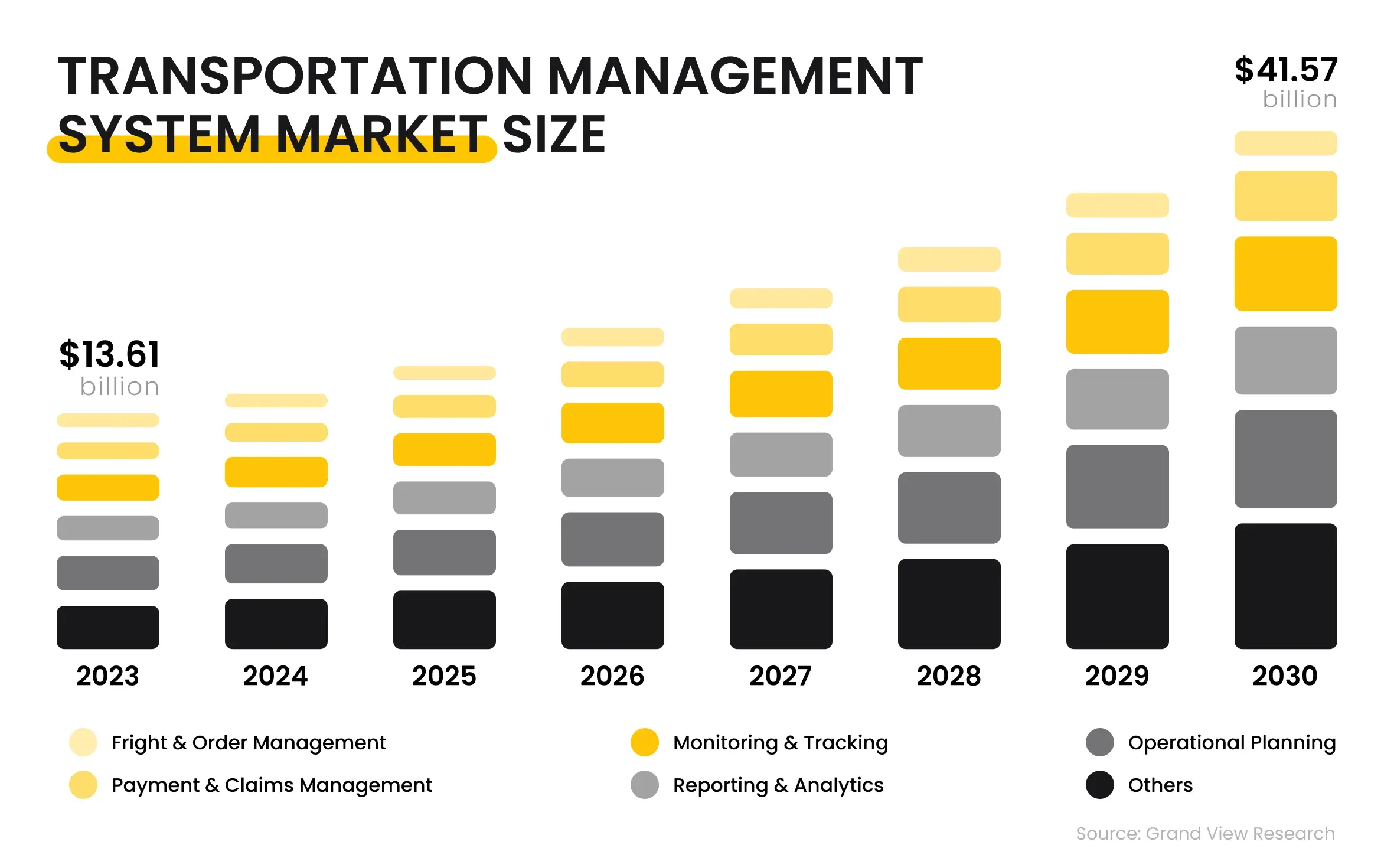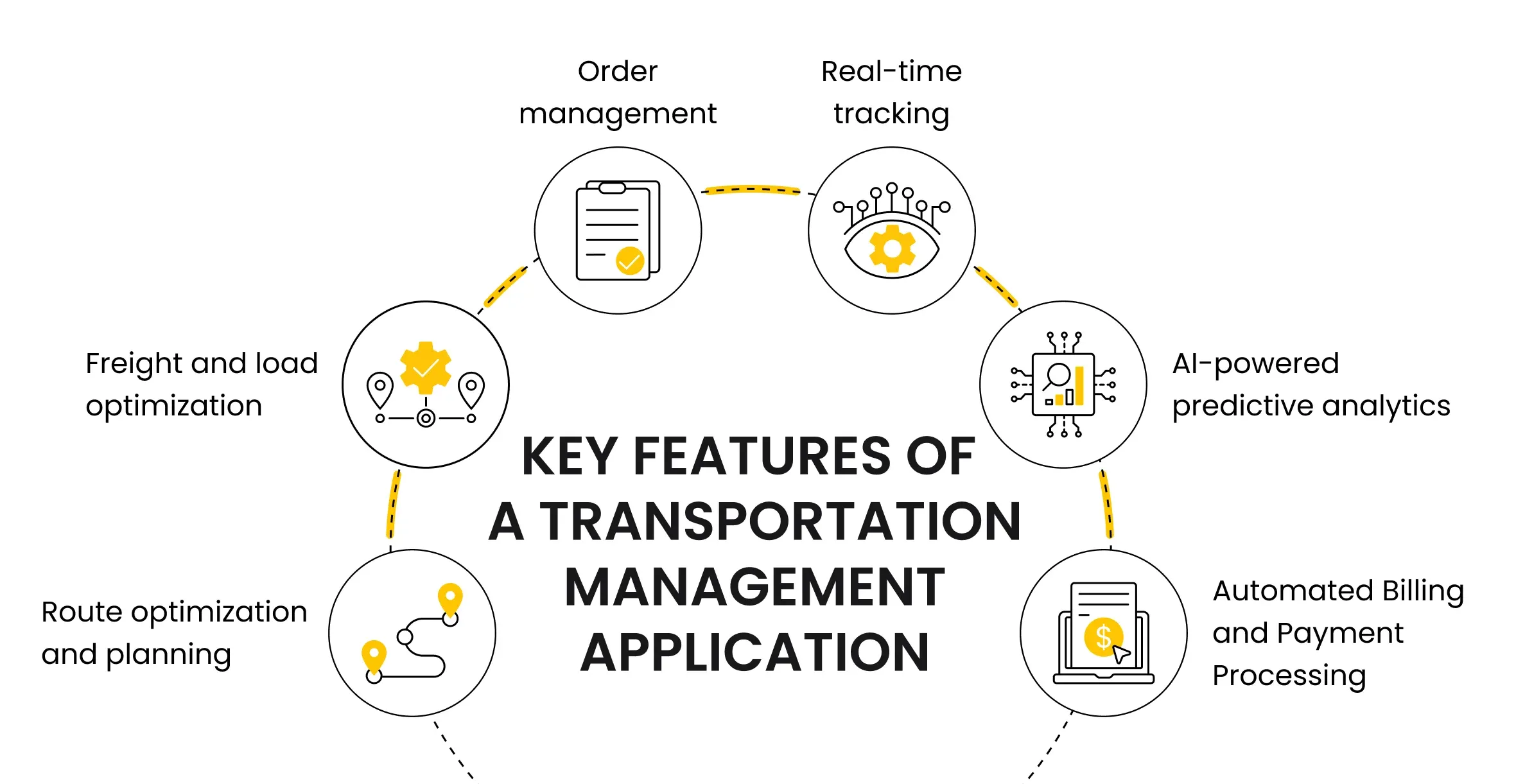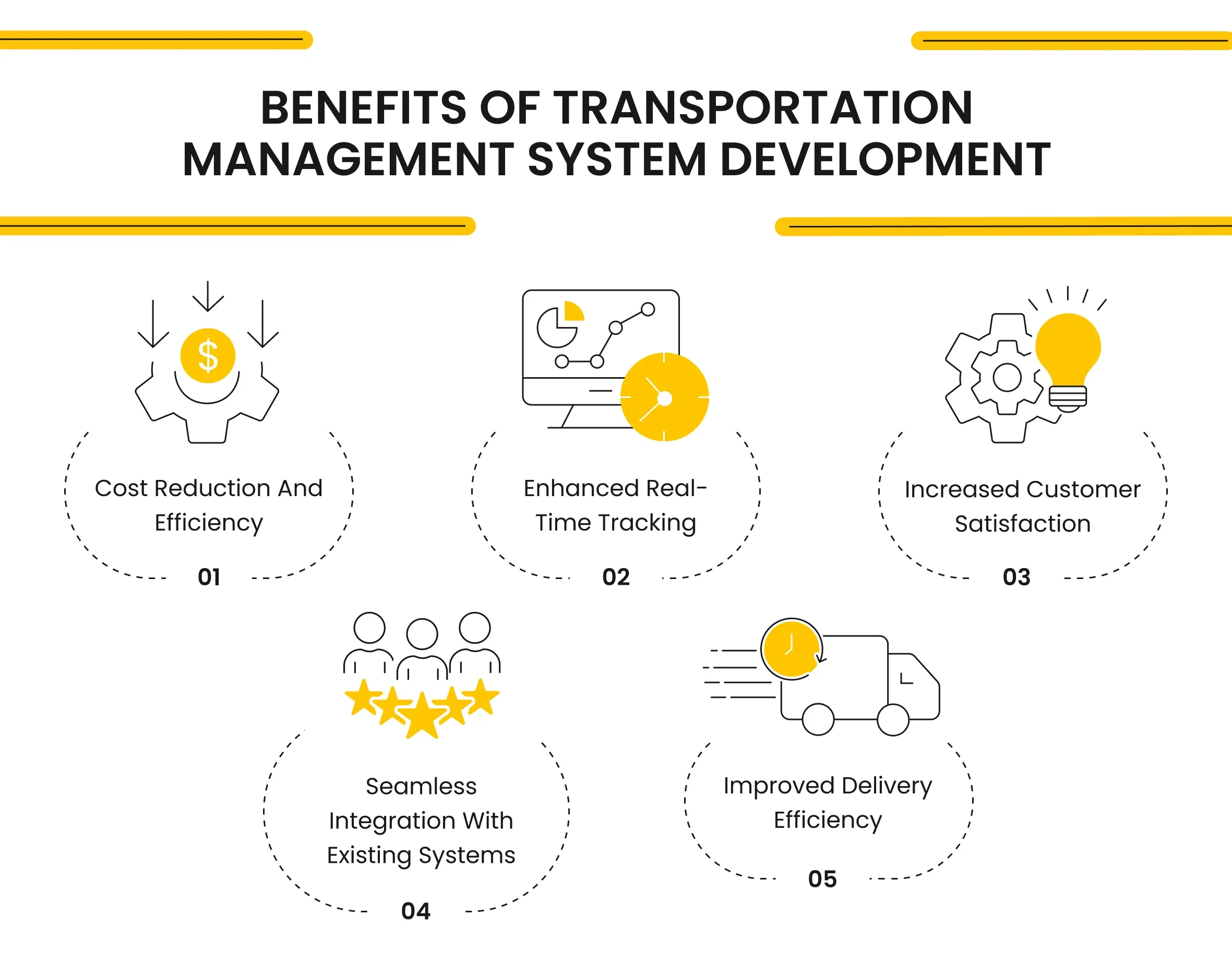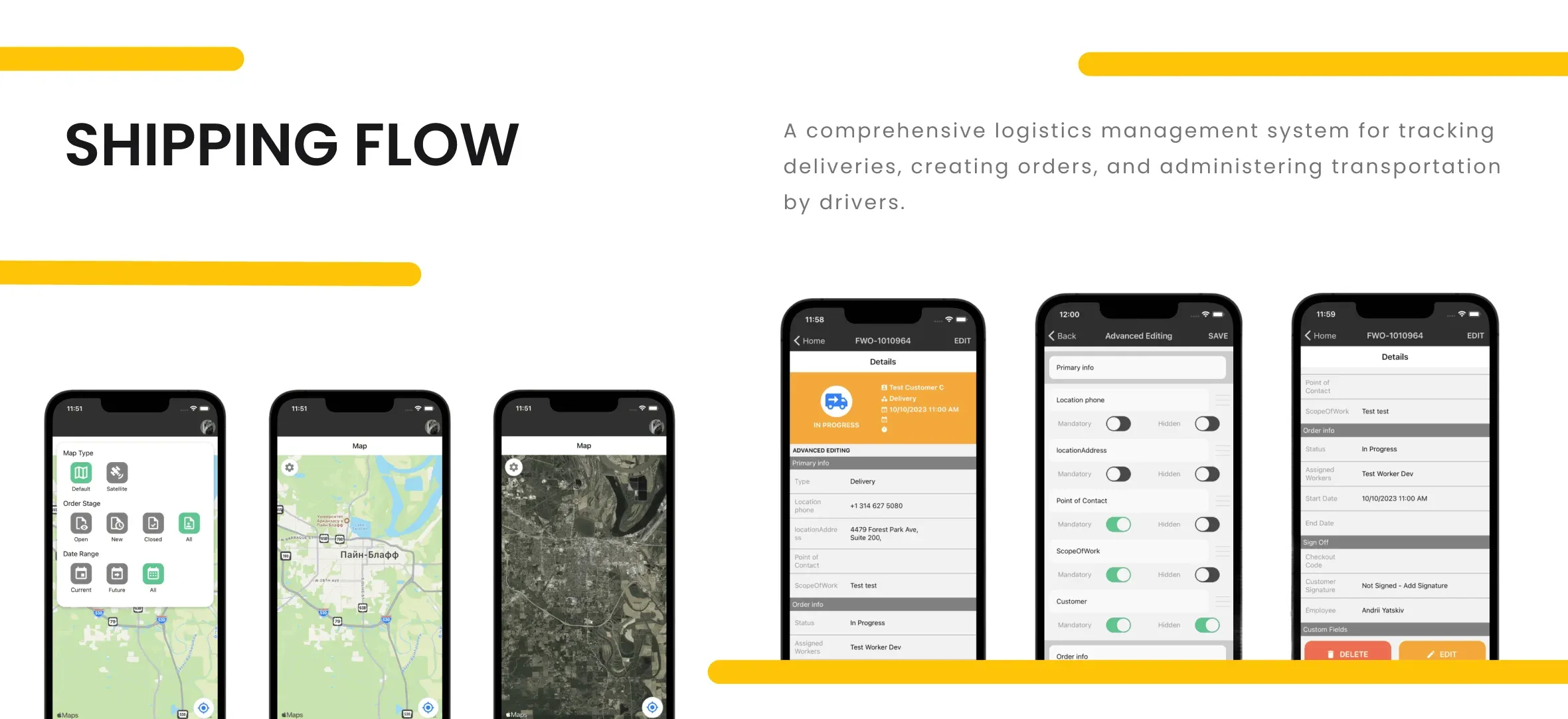Supply Chain
Transportation Management Application Development: Best Practices for Success
March 07, 2025 • 187 Views • 24 min read
Bohdan Vasylkiv
CEO & Co-Founder
The development and adoption of transportation management software solutions in logistics is a stable trend. The reasons are simple: software solutions offer businesses many more tools, helping them scale and improve offered services.
Frankly, the number of advantages of integrating TMS solutions in a supply chain company is limitless. They suggest better management, awareness of undergoing business processes, and ways to streamline certain operations, achieving better efficiency and cost savings.
The core demand for such custom projects is software development experience and expertise. Still, you can easily overcome it using supply chain software development services offered by niche-experienced IT companies.
We must first learn the basics to clarify the need for custom transportation management solutions.
Importance of TMS
Let's define the core roles of TMS systems in the logistics industry.
Long story short, a transportation management system is a centralized digital solution for businesses that suggests more efficient and user-friendly ways to manage processes and track operations.

Still, TMS software can vary, depending on the specifics of the task. It can either work as a full-fledged platform for all administrative tasks or offer tools for niche or specific cases like fleet management, warehouse management, tracking transportation operations, etc.
Such specific systems have different names, such as CRM (customer relationship management), WMS (warehouse management system), SCMS (supply chain management system), and others.
Simply put, transportation management system software is a better solution for administrative tasks that suggests the most transparent and efficient management features available for all employees. Besides, it allows companies to track more processes in real-time, cutting off the intermediary or time for filing reports.
Combined with the fact that modern supply chains are global and spread worldwide, such specialized software becomes a must-have element of the transportation business, not an "extra" functionality. Otherwise, companies can get buried in papers without such management app development.
Moreover, such appreciation of TMS solutions is shown in the latest research. For instance, according to Grand View Research, the transportation management system market was evaluated at 13.61 billion US dollars in 2023 and is expected to grow to 41.57 billion US dollars in 2030.
So, what are the key features of modern transportation management software development projects?
Key Features of a Transportation Management Application

Frankly, using TMS for your logistics business has multiple benefits and advantages. As mentioned, such software solutions significantly impact the overall efficiency of undergoing supply chain management processes and help reduce expenses on certain operations.
Still, it is possible to highlight some of the most potent and beneficial features of transport management systems, which are worth considering first. The list of such features includes:
- Route optimization and planning
- Real-time tracking
- Order management
- Freight and load optimization
- AI-powered predictive analytics
- Automated Billing and Payment Processing
Route Optimization and Planning
First of all, it can help in creating a precise transportation plan. Long story short, thanks to advanced features like map integrations and routing, your team can optimize transportation costs by making more efficient routes based on GPS and other third-party instruments and data.
One of the finest advantages of using such solutions is the flexibility and customization of routes: instead of creating only primarily transportation and logistics routes, SaaS maps like Google Maps or MapBox can make alternative delivery ways based on real-time data updates like traffic jams, closed roads, etc.
Thus, you can create a transportation pipeline with many branches, allowing your drivers to adapt and replan their roads according to actual information, saving your time and money on delivery delays or other aspects of transportation.
Moreover, logistics and transportation companies don't have to spend a lot of their resources on custom software development: such map solutions already exist and require minimal technical skills and resources to integrate into existing transport management software.
Real-time Tracking
Additionally, using TMS solutions with built-in fleet management software development options offers extra beneficial features besides optimized routing. We are talking about real-time inventory management and tracking.
Simply put, such TMS software offers options to track the status of a delivery and even the possibility to define accurate geolocation of cargo, thanks to GPS trackers and other features for drivers.
This significantly boosts the awareness of undergoing operations, clearly understanding what is happening, and rescheduling or postponing various processes based on real-time data.
This might seem insignificant at first. However, such awareness and transparency are crucial for the transportation industry. They provide information and tools to define the challenges or issues during delivery, pinpoint core issues, and decide how to deal with them or avoid them in the future.
Order Management
An order management system is also among the oldest and most important TMS trends. In fact, it is a core solution for real-time tracking and other parcel-related operations.
Such a management system ensures the success and efficiency of all customer order operations like order placing, confirmation, tracking, and delivery. To simplify it, order management covers the whole ordering process, gathering and processing information about such operations.
Apart from giving businesses clarity and data about each order, such systems are commonly used for streamlining this process. For instance, modern inventory management systems can automate all processes, from order placement to delivery execution, cutting out the intermediary employees.
So, companies managing transportation with effective TMS software can relocate their human resources and assign more complex or urgent tasks to their employees.
Freight and Load Optimization
Freight and load optimization are essential aspects of shipment management and are a great addition to routing. Primarily, this optimization is based on transportation data, accessing information from different sources such as warehouses and marketplaces to define the most optimal ways to deliver goods.
For instance, it can be used to relocate goods across the supply chain to reduce transportation costs and time. Besides fulfilling the demand for certain products elsewhere, such optimization helps ensure each freight forwarder's optimal load.
AI-Powered Predictive Analytics
Frankly speaking, AI-based software that helps in predictive analytics is not a must-have feature of every TMS at the moment. Nevertheless, judging from the recent trends in the AI field and the overall simplicity and advantages of such integration, it is possible to assume AI tools will become mandatory in the next few years.
Long story short, AI implementation is an excellent way to upscale your software capacities and efficiency, improve offered services, etc.
One of the core benefits of adopting artificial intelligence in transportation software is its robust functionality. AI is data-driven and can change its behavior according to your needs. Moreover, such instruments can scale using the data and prompts you give them.
If we talk about facts and recent context, AI-powered custom transportation management system can suggest new insights and optimization ways. AI algorithms can distinguish templates and other correlations, upscaling the predictive analytics and suggesting potential trends.
In other words, AI-based TMS software can be used for advanced data analysis and predictive analytics. Still, apart from data-related operations, the same AI solutions can be used for many other activities like process automation.
Automated Billing and Payment Processing
Continuing the automation topic, we should include different solutions for transportation software development projects.
Simply put, apart from improved management efficiency, custom TMS software development can offer many options to streamline different business processes, such as customer support, carrier management, covering each transportation process, etc.
Still, most such streamlined operations are speculative and require extra steps during the software development process, as well as finding and collaborating with a reliable and experienced software product development company.
Nevertheless, automated billing and payment are essential, yet they are simple functionalities you can integrate when creating an advanced transportation management system.
Benefits of Transportation Management System Development

Apart from knowing about use cases for TMS software, we should also describe the core benefits of such solutions. In a nutshell, key advantages of custom transport management software include:
- Cost reduction
- Enhanced real-time tracking
- Seamless integration with ERP, CRM, and supply chain systems
- Increased customer satisfaction
- Improved delivery efficiency
Clearly, there are many other valuable features of the transportation management solutions that help improve different business fields and processes.
Still, key benefits are the most influential and common for all best transportation management software, while the rest might be "extra" and unique for specific systems. Thus, let's discuss only key features.
Cost Reduction
First, thanks to advanced administrative features and services, the transportation management system ensures the cost-efficiency of business processes.
The variety of ways to achieve cost reduction using such software is limitless. However, among the most important, we can name process automation and advanced data analysis.
While the effect of streamlined operations on cost reduction requires no detailed explanation, data analysis can be explained. To cut a long story short, efficient data processing helps identify bottlenecks, issues, or elements that need optimization. With access to such insights, businesses can improve efficiency and cut unneeded or insufficient processes, better managing their resources.
Enhanced Real-Time Tracking
Obviously, TMS solutions for the supply chain industry improve business management operations. It is the core reason for considering the adoption of such software.
Yet, apart from an advanced toolset for administrative tasks, TMS offers instruments to improve tracking practices. As mentioned before, these features can relate to entirely different operations and processes simultaneously, such as parcel status tracking, financial management, process tracking, etc.
Moreover, the status updates take place in real-time, providing business owners with clarity and awareness of undergoing processes on the spot. So, companies can make urgent and right decisions without postponing them. Additionally, it helps to avoid potential risks.
Seamless Integration with Existing Systems
Frankly, this feature is a 100% case for custom transportation software development. If you choose SaaS or other ready-made solutions, seamless integration with existing systems might be tricky.
In a nutshell, in terms of building custom TMS, a software development company aims to satisfy all business needs and expectations. Besides, such projects are oriented toward future software scalability, creating a robust IT infrastructure for scaling and improving functionality.
However, if you choose a ready-made TMS software, you should count all the pros and cons and pay attention to its compatibility with your other software. The easiest and most efficient way to learn about such options - is to ask the software vendor directly.
Increased Customer Satisfaction
Logistics businesses can use a transportation management system to improve their customer satisfaction. Like cost efficiency, process optimization, and improved logistics management, TMS integration can be used to analyze user satisfaction and related factors.
By learning about customers' positive and negative experiences, business owners can improve their experience even more and make their services more competitive and pleasant.
Improved Delivery Efficiency
Finally, transport management solutions obviously help to improve delivery efficiency, positively impacting the corporate budget, brand, and user satisfaction.
Judging from our experience, the best TMS software is custom transportation management software development. Choosing this approach suggests defining your core goals and requirements and finding ways to satisfy them by creating a tailored solution.
Besides, custom projects give business owners complete control over the software infrastructure, giving many more options and advantages in the long run. For instance, they can easily integrate innovative solutions, embody new features and services, etc.
Finally, despite requiring a higher initial budget, custom TMS projects are cheaper in the long perspective: after the software development is done, your only expense will be software maintenance, which can also be reduced using various practices like making a cloud-based transportation management system.
Even if you have already created a custom TMS, you can migrate your system to the cloud on demand with the help of team extension services or using your in-house software developers.
Best Practices for Transportation Management Application Development
In addition to learning about the use cases and benefits of adopting TMS into your logistics business, it is preferable also to learn some best practices for transportation management app development and integration.

Like any other industry, the software development field has a lot of nuances and specifics. To be honest, each software development project is unique and requires an appropriate approach, including detailed planning, business needs exploration, and other preparations.
Nevertheless, it is possible to highlight three core practices that have proven their efficiency and should be considered when you integrate or develop a transportation management software:
- Implement scalable and secure cloud-based infrastructure
- Leverage AI and machine learning for smart decision-making
- Focus on data security
Implement Scalable and Secure Cloud-Based Infrastructure
Everyone wants a robust transportation management system. Judging from those above, it might seem that building custom software with whole control and on-premises is the best possible scenario. However, we recommend choosing cloud-based over self-maintained infrastructure.
The reasons for this are simple: despite engaging a third party like Amazon, Microsoft, or Google in your software, this can bring a lot of benefits to the table.
First of all, such cooperation helps to cut infrastructure maintenance expenses because cloud computing is always cheaper than self-hosted servers.
Apart from that, cloud vendors offer multiple service packages, which can significantly speed up the development pace by integrating existing functionality.
Finally, many such third parties take care of cloud upgrades and improvements, constantly enhancing security measures, deploying new features, and finding ways to offer the best services. Cloud-based solutions prove to be more scalable and secure than self-maintained software.
Leverage AI and Machine Learning for Smart Decision-Making
The revolution of artificial intelligence that took place after the emergence of ChatGPT brought multiple valuable and powerful software instruments.
Despite the possible skepticism of AI integrations and the potential threats they can bring, it is hard to deny their influence on the modern software market. Almost every IT company has implemented or plans to perform such integration soon.
Frankly, AI offers too powerful and innovative solutions and services to ignore. Thus, instead of refusing to integrate AI-powered instruments, it is better to consider ways to ensure the security and efficiency of such implementation and secure vulnerable data.
Focus on Data Security
Data security is one of the most critical aspects worth considering, regardless of what type of software you are developing or integrating.
Each software is data-driven. It requires access to data and information to operate efficiently and perform required tasks. Nevertheless, such a requirement brings a lot of challenges, including international laws and regulations like GDPR.
Fortunately, there are multiple ways to ensure the best security practices and overall system protection. Any qualified software engineer should be familiar with such terms as OWASP or its alternatives.
In addition to such well-known terms and vulnerability lists, protection is highly flexible and specific, depending on the context of your project. Probably the only common security factor that is fair for every software - is to get rid of legacy systems and constantly update your software, finding and fixing bugs, errors, or even backdoors.
Transportation Mobile Application Development with Incora
To illustrate efficient software for transportation planning and execution, we can name one of our latest cases: Shipping Flow.

It is a centralized management platform that covers different aspects of the transportation process, starting with simple built-in chats for faster communication between various parties and ending with real-time visibility and data updates of a fleet management system.
While designing and developing this TMS solution, we paid much attention to the system's protection and infrastructure efficiency, preparing it for future scaling.
As a result, our clients got a working logistics software on demand that covers most of their business demands and is flexible enough for additional functionality implementation.
What’s your impression after reading this?
Love it!
1
Valuable
2
Exciting
1
Unsatisfied
1
FAQ
Let us address your doubts and clarify key points from the article for better understanding.
How much does a TMS system cost?
The cost of a TMS (Transportation Management System) varies widely based on features, deployment type (cloud vs. on-premise), and company size. Prices can range from $10,000 to $250,000+ for mid-sized businesses, with enterprise solutions costing even more. Cloud-based TMS options often have subscription pricing, starting at $500 to $5,000 per month.
How can AI and automation improve transportation management?
AI and automation enhance transportation management by optimizing route planning, reducing fuel costs, improving load efficiency, and minimizing delays. They also enable real-time tracking, predictive maintenance, and automated decision-making, leading to increased efficiency, cost savings, and better customer service.
How can a transportation management app improve delivery times?
A transportation management app improves delivery times by optimizing routes, providing real-time tracking, automating dispatch, and predicting delays. It enhances coordination, reduces downtime, and ensures faster, more efficient deliveries.
Can an existing logistics system be integrated with a Transportation Management Application?
Yes, most Transportation Management Applications (TMAs) can integrate with existing logistics systems using APIs, EDI, or custom integrations. This allows seamless data exchange, improved visibility, and enhanced operational efficiency without overhauling the entire system.
you may also like
Let’s talk!
This site uses cookies to improve your user experience. Read our Privacy Policy
Accept

Share this article